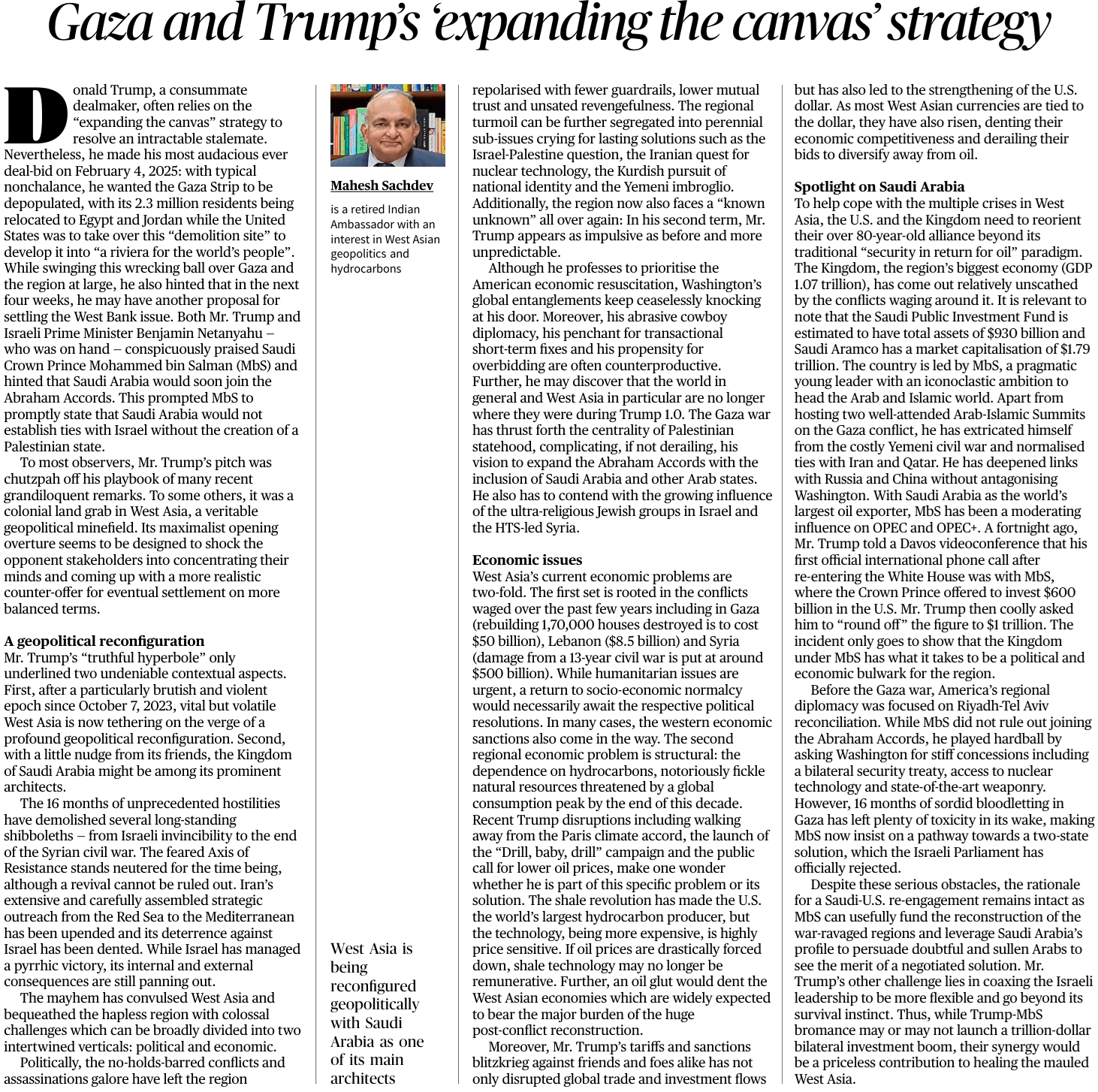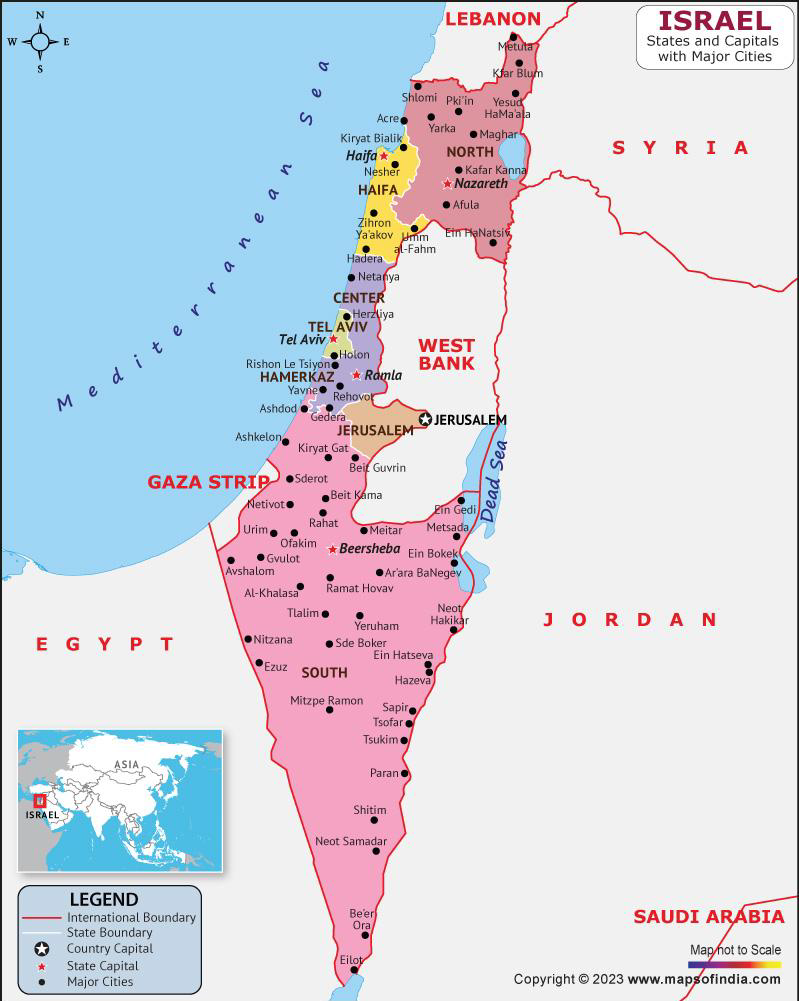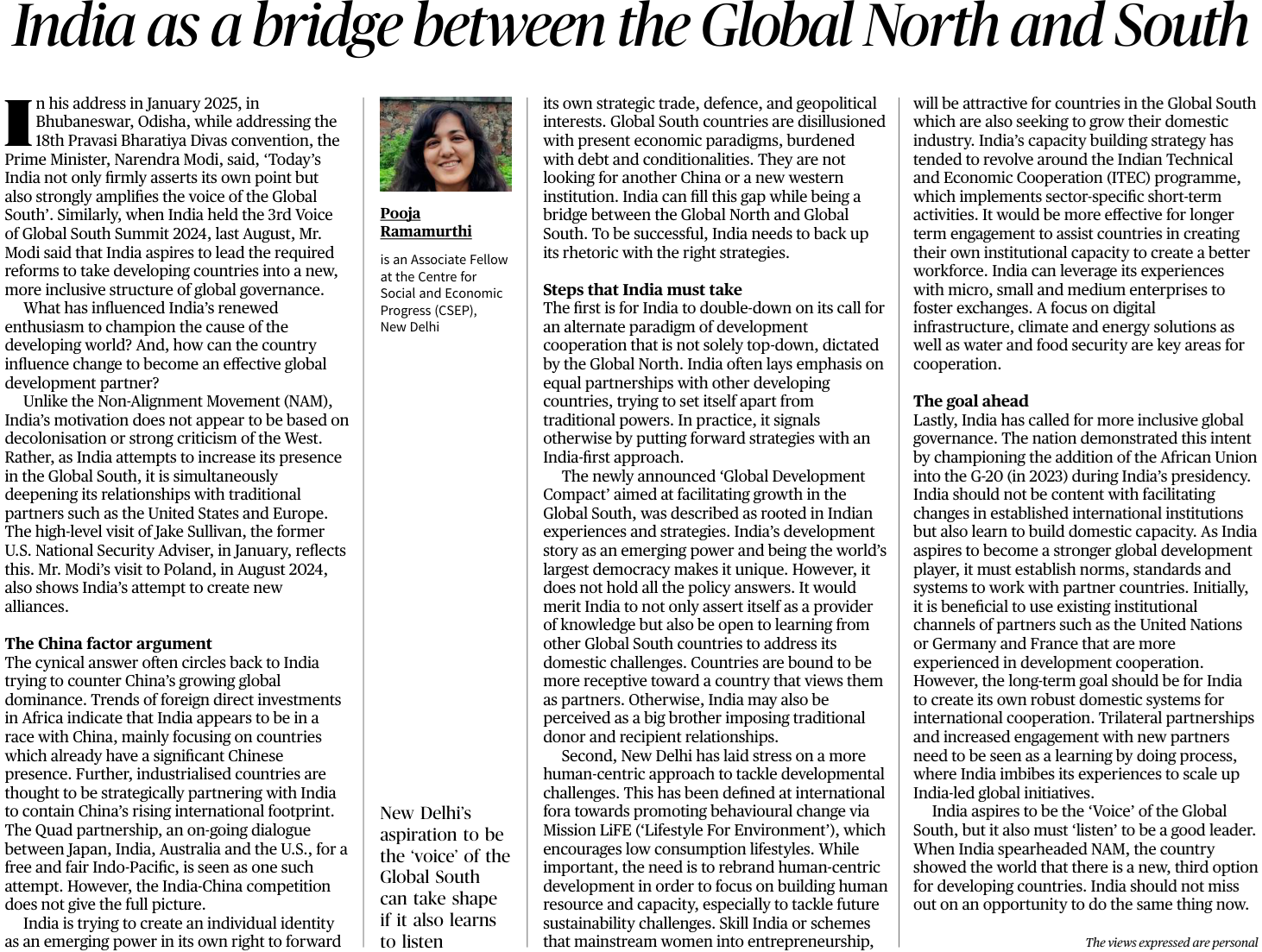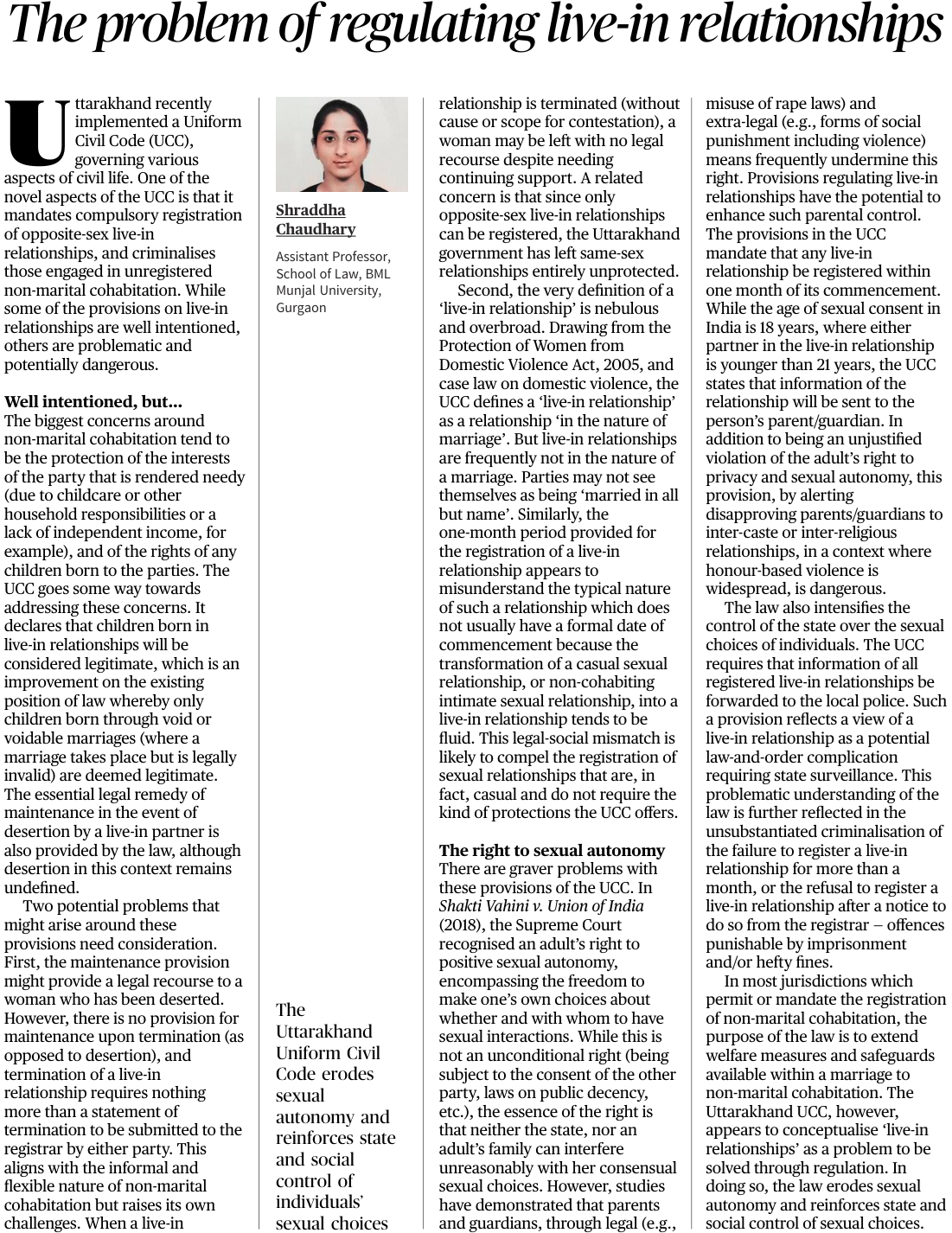1. West Asia's Geopolitical Shift: Gaza, Trump, and Expanding the Canvas Strategy
Introduction
- Former U.S. President Donald Trump proposed a controversial strategy for Gaza, suggesting depopulation and redevelopment.
- This approach aligns with his “expanding the canvas” strategy, where extreme proposals are made to force stakeholders into negotiations.
- The plan reflects broader geopolitical shifts in West Asia, especially involving Israel, Saudi Arabia, and Palestine.
Geopolitical Reconfiguration in West Asia
- Contextual Background:
- Post-October 7, 2023, violence has destabilized West Asia.
- The conflict has led to a shifting power balance with Saudi Arabia emerging as a key player.
- Israel-Palestine Conflict:
- Gaza war has intensified the Palestinian struggle for statehood.
- Saudi Arabia’s hesitation to normalize ties with Israel without Palestinian resolution adds complexity.
- S. Strategy & Trump’s Role:
- Trump’s transactional diplomacy aims at forcing rapid solutions.
- However, his approach remains unpredictable and often escalates tensions.
Economic Challenges in West Asia
- War-induced economic damage:
- Gaza reconstruction cost: $50 billion.
- Lebanon’s crisis: $8.5 billion loss.
- Syria’s war damage: Around $500 billion.
- Western sanctions further hinder recovery.
- Structural Economic Issues:
- Oil dependency makes West Asian economies vulnerable to external shocks.
- De-dollarization efforts are increasing, impacting U.S. economic influence.
Saudi Arabia’s Role & Global Energy Dynamics
- Saudi Arabia’s Strategic Position:
- Key oil exporter with influence over OPEC.
- Balancing ties between the U.S., Russia, and China.
- Abraham Accords and diplomatic recalibration.
- Impact on Global Politics:
- Oil pricing decisions affect inflation and economic stability worldwide.
Increasing economic diversification efforts in the Gulf nations.
Conclusion
- The ongoing Gaza conflict, Trump’s bold proposals, and Saudi Arabia’s strategic recalibration mark a new phase in West Asia’s geopolitics.
- The region remains in flux, with economic, political, and diplomatic maneuvers shaping its future.
- Any resolution to the conflict will require a multilateral approach that balances U.S., Israeli, Palestinian, and Arab interests.
Bottom of FormMains Practice Question |
Q. “West Asia is undergoing a profound geopolitical and economic transformation.” Discuss the factors driving this shift and its implications for global politics and India. |
2. India as a Mediator Between the Global North and South
Introduction
- India has positioned itself as a bridge between the Global North and South, advocating for reforms to create a more inclusive global order.
- Unlike the Non-Alignment Movement (NAM), India’s current approach focuses on deepening relations with both developing and developed nations.
- India’s engagement with global powers like the U.S. and Europe, along with its leadership in the Global South, reflects its aspiration for a balanced foreign policy.
India’s Motivation for Global Leadership
- Strategic Engagement:
- Balancing relations between the Global North (U.S., Europe) and South (Africa, Latin America, developing Asia).
- Hosting the 3rd Global South Summit in 2024 as a step toward inclusive governance.
- Countering China’s Influence:
- China’s growing investments in Africa and its Belt and Road Initiative (BRI) challenge India’s role.
- The India-Japan-Australia-U.S. Quad partnership aims to counterbalance China’s expansion.
Key Steps India Must Take
- Alternative Development Model:
- Promote a development approach distinct from the West’s, focusing on equitable partnerships.
- The ‘Global Development Compact’ emphasizes shared learning and domestic capacity building.
- Economic and Technological Cooperation:
- Enhancing India’s Technical and Economic Cooperation (ITEC) program for long-term engagement.
- Strengthening micro, small, and medium enterprises (MSMEs) for global economic integration.
- Sustainable and Human-Centric Development:
- India’s initiatives like Mission LiFE (Lifestyle for Environment) promote eco-friendly policies.
- Need to balance climate goals with industrial growth to maintain leadership in the Global South.
Challenges and Future Prospects
- Global Perception and Strategic Dilemmas:
- If seen as a mere donor, India risks being viewed as another power imposing traditional aid models.
- Balancing traditional diplomacy with an independent identity remains a challenge.
- Building Domestic Systems for Global Leadership:
- India must strengthen institutions, norms, and regulatory frameworks to become a sustainable global leader.
- Engaging in multilateral platforms like the UN and G20 to institutionalize its role in development cooperation.
Conclusion
- India’s ambition to lead the Global South must be backed by well-structured policies, long-term economic engagement, and capacity-building initiatives.
- While India advocates for reforms in global governance, it must also listen and adapt to evolving global expectations.
- Just as NAM once provided a third option during the Cold War, India now has the opportunity to offer a new development paradigm for emerging economies.
Mains Practice Question |
Q. “India’s role as a bridge between the Global North and South presents both opportunities and challenges.” Discuss how India can navigate these challenges to establish itself as a leader in global governance. |
3. Regulating Live-in Relationships: Legal and Social Challenges
Introduction
- The Uttarakhand Uniform Civil Code (UCC) mandates compulsory registration of opposite-sex live-in relationships and criminalizes unregistered non-marital cohabitation.
- While intended to protect vulnerable partners and children, certain provisions raise concerns about privacy, autonomy, and social control.
Legal and Social Implications
- Protection of Vulnerable Partners and Children
- Recognition of children born in live-in relationships as legitimate.
- Provision for maintenance in cases of desertion but not upon termination of the relationship.
- Challenges in Defining a Live-in Relationship
- The UCC defines live-in relationships as those “in the nature of marriage,” which is vague and open to broad interpretation.
- One-month registration rule misinterprets live-in relationships as contractual, whereas many evolve informally.
- Concerns Over Sexual Autonomy and Privacy
- Supreme Court in Shakti Vahini v. Union of India (2018) upheld an adult’s right to consensual relationships.
- Mandatory registration and police notification may interfere with personal choices, particularly in interfaith or inter-caste relationships.
- Potential for Misuse and Social Policing
- Informing parents/guardians of relationships involving individuals under 21 years could enable honor-based violence.
- Compulsory police intimation turns live-in relationships into law enforcement matters, inviting unnecessary surveillance.
Comparative Perspective and Broader Issues
- Most jurisdictions focus on providing welfare protections rather than regulating consensual adult relationships.
- The UCC’s approach risks moral policing rather than safeguarding rights.
Conclusion
- While regulation of live-in relationships can provide social security benefits, the Uttarakhand UCC’s approach raises concerns over privacy, autonomy, and social control.
- A balanced approach should focus on legal protections without infringing on personal freedoms.
Mains Practice Question |
Q. “The regulation of live-in relationships must balance legal protections with individual autonomy.” Critically analyze the Uttarakhand UCC provisions on live-in relationships in light of this statement. |





